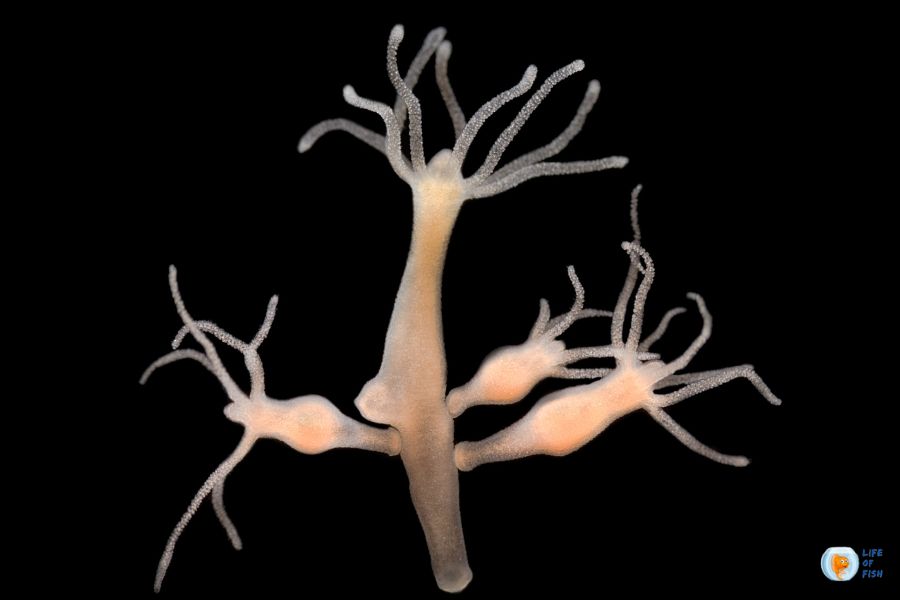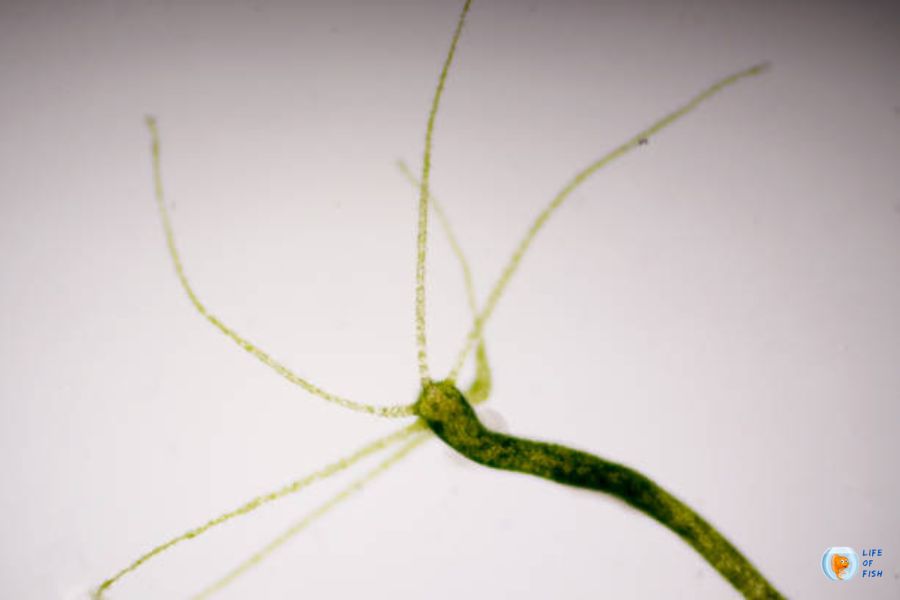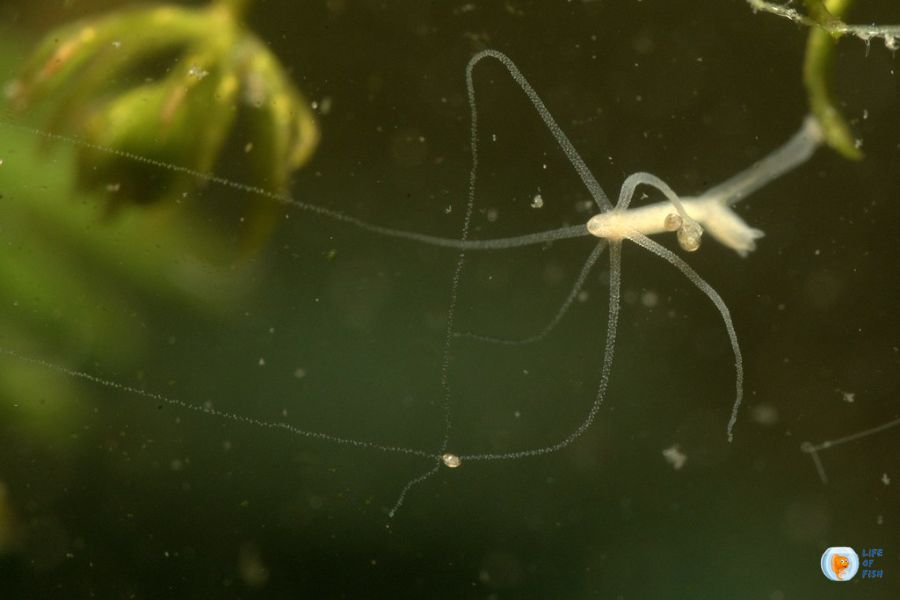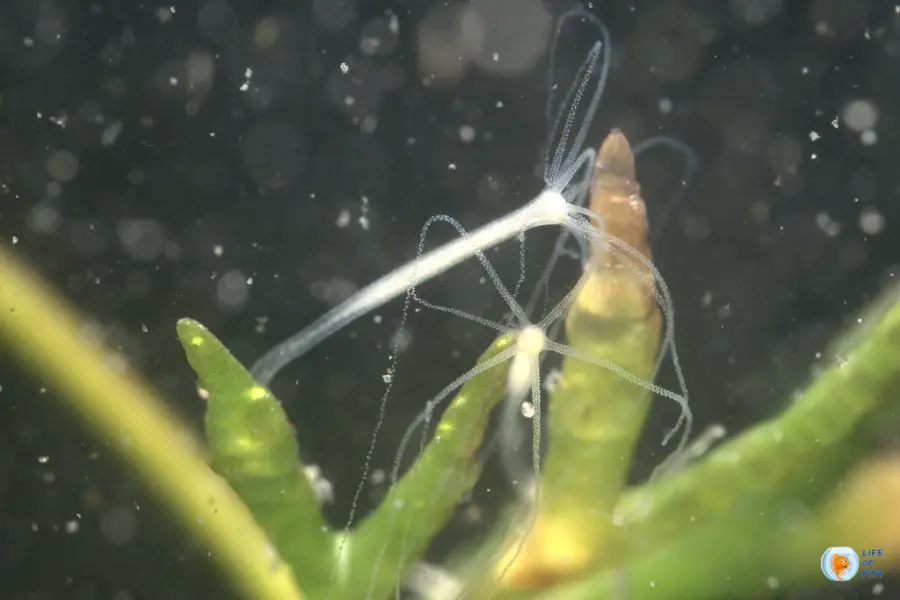Spotting the presence of the Hydra in your aquarium can be quite a shock, as these tiny creatures can multiply rapidly and take over an entire tank. These tiny tentacle monsters may not look dangerous, but they can actually harm most fish and other aquarium inhabitants.
Hydra can also make your aquarium look unpleasant when multiplied rapidly. As with any uninvited guest, it’s important to take action to get rid of the Hydra and ensure that your aquarium remains clean.
This article will guide you on identifying Hydra and the steps to take for its removal.

What Is Hydra In Aquarium?
Jump To
- 1 What Is Hydra In Aquarium?
- 2 How To Identify Hydra In Aquarium
- 3 What Causes Hydra In Aquarium?
- 4 Is Hydra Visible To Human Eye?
- 5 Is Hydra Dangerous To Fish?
- 6 Are Hydras Dangerous To Humans?
- 7 How To Get Rid Of Hydra In Aquarium?
- 8 How to prevent infestation of Hydra in Aquarium?
- 9 How to prevent hydra infestation in the shrimp tanks and breeding tanks?
- 10 What Eats Hydra In Aquarium?
- 11 Conclusion
- 12 Related Questions
Hydra is a type of freshwater invertebrate that belongs to the Cnidaria phylum and the Hydra family. They have a tubular body topped with a crown of tentacles used for hunting and feeding. They range in size from less than a centimeter to up to 3 inches in length. Hydra can survive in a variety of conditions and they prefer to live on rocks, plants, or the substrate at the bottom of an aquarium.
How To Identify Hydra In Aquarium
Hydra can be difficult to spot, as they are usually less than 1 cm in size and blend in well with their surroundings. As such, it’s important to learn what to look for in order to identify them. The most distinguishing feature of Hydra is their tentacles, which they use to capture and consume prey. They also have a head with two small eyespots located on either side.
While it may be difficult to identify Hydra when they are in the aquarium, picking up some of them by hand will help you better investigate them. Although Hydra also has a “stinger” like jellyfish, it will only deliver a mild sting that does not cause any harm. Using a magnifying glass to inspect them more closely also helps.
What Causes Hydra In Aquarium?
Hydra can be introduced to an aquarium through water, plants, or even fish. They may also be present in tank decorations and gravel and can be brought in on hands or equipment from another tank. In addition, uneaten food left in the aquarium can attract Hydra and create an ideal environment for them to reproduce.
What makes them dangerous is their reproductive capability and their ability to prey on several times their size. Hydra is Parthenogeneic (meaning they don’t need a mate to reproduce) and can regenerate their tentacles if any are lost or damaged. They reproduce asexually by producing buds that grow into new Hydra. These Hydra then break off and go out on their own. So, even if you don’t introduce an alive hydra into your aquarium, a part of the Hydra can grow into a new hydra in just a couple of weeks, which will multiply rapidly sooner. Therefore, accidentally introducing just one Hydra can be disastrous if left untreated.

Is Hydra Visible To Human Eye?
Most Hydra that is present in aquariums are quite small, so they can be difficult to spot with the naked eye. However, with a little bit of patience and careful observation, you should be able to spot them. They come in various sizes, ranging from less than an inch to up to 3 inches long, and are topped with tentacles on the crown. They should be simple to identify if you know what they look like.
The color of Hydra can range from light brown to dark green, depending on the species. However, this color will be visible only if you use a magnifying glass to identify them.
Is Hydra Dangerous To Fish?
Although these species are extremely small, they can cause a lot of damage to the fish and other inhabitants in your aquarium when left unchecked. Hydras are predatory and have powerful tentacles that can trap small fish and other small animals (which are several times larger than themselves). They can also consume food intended for the fish, leading to malnutrition in your tank.
Usually, a small population of Hydra is nothing to worry about, as their small size makes them easy prey for larger fish. However, if the population grows out of control, it can cause serious problems in your aquarium.
Are Hydras Dangerous To Humans?
No, Hydra is not dangerous to humans. They are too small to do any real damage, and the worst Hydra can do give you a small bite that is no worse than a mosquito bite.
However, some people may experience an allergic reaction to the venom of Hydra, so it is important to be careful when handling them.
How To Get Rid Of Hydra In Aquarium?
There are several ways to get rid of Hydra in an aquarium. Which method to use will depend on the size of the population and how badly they are affecting your tank.
Manually remove them from the tank.
This is by far the most secure and efficient approach to removing Hydra from your tank. Use tweezers or a net to scoop them out of the tank and dispose of them in a trash can. This method is especially effective for small numbers of Hydra.
If you use this method to remove Hydra from the aquarium, you should be careful with several things, which are,
- The population should be small
Hydra is a fast-growing species that can quickly become a huge problem if left unchecked. Manual removal will only work if you catch them early enough.
- You should not break off any pieces of Hydra in the aquarium.
If you accidentally break off Hydra into some pieces, it will lead to a new Hydra growing in your tank as the pieces can regenerate into a new Hydra. (Remember that we mentioned that Hydra is an asexual species).
Cease the food sources of Hydra
Another method to remove Hydra from the aquarium is to cease the food sources that are attracting them. Uneaten food left in the tank can be a great source of nutrition for Hydra and you should remove right away. If your aquarium already has any livestock, it will be difficult as you must stop feeding them altogether.
As a solution, you can use target feeding methods to ensure that fish eat all the food and make sure all is clear.
Introduce predators
The third way to get rid of Hydra in your aquarium is by introducing predatory fish that will eat them. For this, you’ll need a large tank with lots of hiding places for the predators and enough food to feed them.
Some popular predators of Hydra are Bettas, Plecos, and some species of Loaches.
Heat The Tank
High temperatures can kill Hydra, but this is not a good option if you have live plants and livestock. Increasing the temperature of your aquarium can also kill the plants, good bacteria, and fish. However, if the infestation is high, this might be the best option to get rid of Hydra. First, you must relocate your fish to a temporary tank before increasing the temperature. Then set the temperature to 40C (104F) and leave it for about 2 hours. Hydra will die and fall to the bottom. Then vacuum the Hydra and perform at least a 50% water change.
Finally, you should clean the tank and filter media thoroughly to make sure all the remains of Hydra are removed from the aquarium.
Leave the tank to drop the temperature, and then you can reintroduce your fish.
Using Chemical Treatment
Chemical treatment is an effective way to reduce the population of Hydra in an aquarium. However, it is the least desirable way due to its potential toxicity. Several commercial products available can be used as a chemical treatment for Hydra in your aquarium, generally using some copper-based compound.
It is important to be very careful when using chemical treatment, as it can be hard to know exactly how much is safe for your tank.
Some aquarists even use deworming agents to get rid of the Hydra, although this is not recommended as it can be hard to judge how effective it will be.
The best way to get rid of Hydra in your aquarium is by manually removing them, ceasing their food source, heating the tank, or introducing predators. You should only use chemical treatments if all of these methods fail.

How to prevent infestation of Hydra in Aquarium?
Proper maintenance is the best way to prevent Hydra’s infestation in the aquarium. Regular water changes, vacuuming the substrate, and removing uneaten food will go a long way in keeping your tank Hydra-free.
It is also essential to make sure that any livestock or decorations you introduce into the aquarium are not carrying Hydra or other parasites. Quarantining new fish and decorations for at least a few weeks is a good practice and will help ensure that your tank remains healthy.
You should always avoid live food unless it is purchased from a reliable vendor. Live foods may carry parasites like Hydra or diseases that can infect your tank and cause an infestation.
Finally, do not overfeed the fish in your aquarium, as this can increase nutrient levels, which will be attractive to Hydra. If you keep your tank clean and well-maintained, it should be relatively easy to maintain Hydra-free.
Tip: If you suspect your new plants, rocks, and other decorations may be carrying Hydra, it is best to clean and disinfect them before introducing them into the aquarium. You can use a tablespoon of dissolved alum in a quart of water and soak the items for 10 minutes. This should help kill any Hydra and eggs on them.
How to prevent hydra infestation in the shrimp tanks and breeding tanks?
Since shrimps and fish fries are delicate creatures, preventing a hydra infestation in these tanks is even more important. Hydra can easily prey on them and cause the population in a tank to decrease drastically.
To prevent a hydra infestation in shrimp tanks, do not overfeed the tank, as uneaten food will lead to a higher nutrient level in the tank, attracting more Hydra. Most aquarists make the mistake of overfeeding their shrimp and fries to make sure that the food is eaten. You should definitely avoid this.
Most fish breeders avoid predator fish in their breeding tanks to ensure their fry isn’t eaten. However, you will need at least some types of predators to keep Hydra from taking over the tank. Some suitable choices are snails, as they are not aggressive towards fry and will clean up any uneaten food. Snails will happily munch on non-moving Hydra but will be lazy to go after fish fry and shrimp as they are more active.
Regular water changes and vacuuming the substrate can also help reduce the amount of available food for Hydra and reduce the nutrient levels in the tank. This is particularly important in shrimp tanks and breeding tanks, where food can quickly build up, resulting in a hydra infestation.
In conclusion, it is important to take the necessary precautions in order to prevent a hydra infestation in your shrimp tank, as most treatments are not suitable or safe for delicate shrimp and fry.

What Eats Hydra In Aquarium?
We have already mentioned some predators that can be used to eat Hydra in aquariums, such as snails and other small crustaceans.
Fish also eat Hydra in aquariums, but it’s important to be careful when selecting what type of fish. Guppies and tetras are peaceful fish that will not harm the other inhabitants of your tank but will also not eat Hydra.
Fish such as cichlids, gouramis, paradise fish, loaches, and catfish are much better choices as they are more aggressive in nature and will actively hunt down Hydra to eat. It is essential, however, to make sure that the fish you choose are not too aggressive and that they won’t attack the other inhabitants of your tank.
In conclusion, there are several predators that can be used to keep Hydra populations in check in your aquarium. Careful selection of the right predators is essential to ensure that they do not overpopulate or harm any other inhabitants of your tank. Snails, assassin snails, and certain types of fish are suitable for keeping Hydra populations under control. You can easily keep your tank free from Hydra with the right predators and good maintenance.
Conclusion
Hydra infestation can be a serious issue in aquariums, but it doesn’t have to be. You can easily keep your tank free from Hydra with the right preventative measures and good maintenance. This post has gone through some of the most effective methods for keeping Hydra out of your aquarium, including utilizing predators that actively seek and consume Hydra. Regular water changes and vacuuming the substrate may also assist in limiting Hydras food supply while maintaining your tank clean. With a little more effort and attention, you may easily avoid Hydra in your aquarium.
Related Questions
Can Hydra Survive Out Of Water?
Yes. Unfortunately, Hydra can survive out of water for up to several weeks, depending on their environment. This makes them difficult to eliminate as they can move to a new location.
How Do You Kill Hydra Without Killing Shrimp?
Most chemical treatments designed to kill Hydra will also kill shrimp. The safest and most effective way to eliminate Hydra is through natural predation, such as snails or certain types of fish. Regular water changes and vacuuming the substrate can also reduce Hydra’s food, making it harder for them to survive.
Will Hydra Go Away On Its Own?
If Hydra doesn’t get enough food, they will eventually go away. Proper maintenance of the aquarium can reduce the amount of food available for Hydra and make it difficult for them to survive. However, it is important to be vigilant and eliminate any Hydra that appears in order to avoid an infestation.
Are Hydra Attracted To Light?
Hydra is not actively attracted to light, but they can be drawn to areas of the tank where there is more light in order to find food. This is why it’s important to take care when placing lights in your aquarium, as too much light can attract Hydra. Keeping the lights on for a few hours each day should be enough to provide your fish with the light they need without attracting Hydra.
Read Next : How To Remove Algae From Fish Tank Glass?
